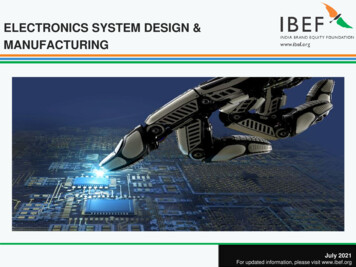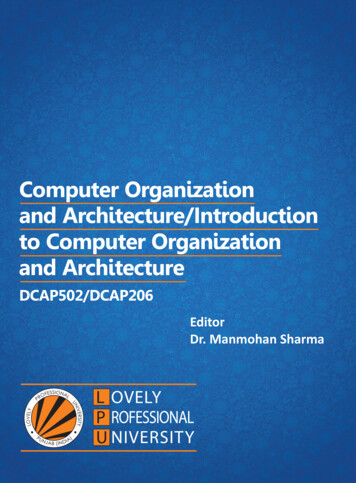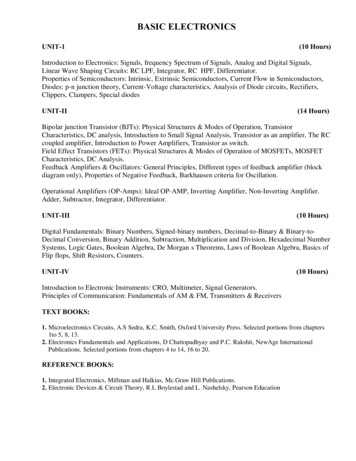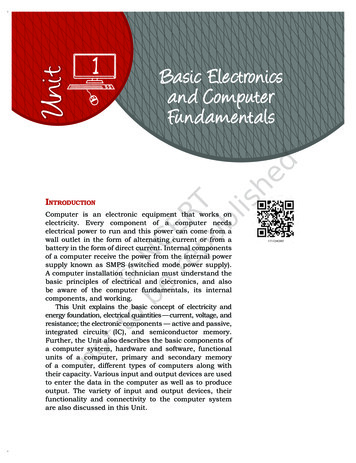
Transcription
1Basic Electronicsand ComputerFunda mentalsIntroductionComputer is an electronic equipment that works onelectricity. Every component of a computer needselectrical power to run and this power can come from awall outlet in the form of alternating current or from abattery in the form of direct current. Internal componentsof a computer receive the power from the internal powersupply known as SMPS (switched mode power supply).A computer installation technician must understand thebasic principles of electrical and electronics, and alsobe aware of the computer fundamentals, its internalcomponents, and working.This Unit explains the basic concept of electricity andenergy foundation, electrical quantities — current, voltage, andresistance; the electronic components — active and passive,integrated circuits (IC), and semiconductor memory.Further, the Unit also describes the basic components ofa computer system, hardware and software, functionalunits of a computer, primary and secondary memoryof a computer, different types of computers along withtheir capacity. Various input and output devices are usedto enter the data in the computer as well as to produceoutput. The variety of input and output devices, theirfunctionality and connectivity to the computer systemare also discussed in this Unit.
Chapter1Basic ElectronicsIntroductionElectricity has an important place in modern society.In the current age, most of the electronic devices workon electricity. Computer is also an electronic devicewhich works mainly on electricity. The peripheraldevices attached to the computer also work onelectricity. It is necessary to provide proper andcontinuous power to the electronics equipment towork properly. For this purpose, the surge protectorand uninterrupted power supply (UPS) are used,which also work on electricity. Hence, electricity hasan important place in the world of computing andcomputer. In this Chapter, you will understand thebasic concept of electricity, electrical quantities, andvarious electronic components.ElectricityElectricity is the set of physical phenomena associatedwith the presence and flow of electric charge.It has a wide range of well-known effects, such aslightning, static electricity, electromagnetic induction,and electrical current.Energy FoundationElectric charge is a fundamental physical property ofmatter. The forms of matter are—solid, liquid, and gaseswhich are made up of atoms. Atoms are the fundamentalbuilding blocks of all molecules. The centre of an atomis called the nucleus. Atoms consist of three subatomicparticles — protons, electrons, and neutrons. Electronsspin around the nucleus in shells, at a great distancefrom the nucleus. Protons carry a positive ( ) charge,electrons carry a negative (-) charge, neutrons are neutraland have no net charge. One coulomb of charge is equalto 6 1018 (6,250,000,000,000,000,000) electrons.Unit 1.indd 209-Oct-19 2:17:09 PM
Protons are found in the center of the atom, with acharge of 1 and a mass of 1 atomic mass unit, whichis approximately equal to 1.66 10. Electrons are foundin the periphery of the atom and have a charge of -1.They are much smaller than protons and their mass is1/1836 amu.The steady flow of electrons is called current. Currentis what flows through electrical wires and powerselectronics items, from light bulbs to televisions.The positively charged protons attract negativelycharged electrons, hence holding the atomic structureas shown in Figure 1.1.Conductors and InsulatorsThe materials can be categorised as insulators orconductors based on its physical property known asresistivity. In an insulator, the electric charge doesnot flow freely from one atom to another due to highresistivity. In a conductor, the electric charge flowsfreely from one atom to another due to low resistivity.This flow of charge is electric current.Neutron(No charge)Protron( ve charge)Electron(-ve charge)Fig. 1.1: Atomic structure–– – –Fig. 1.2: Atoms in a wire, showing electrons travelling from one atom toanother atomConductorsThe material in which the electrons are loosely held canmove very easily. These are called conductors. Metalslike copper, aluminium, and steel are good conductorsof electricity.InsulatorsThe materials which hold their electrons very tightly donot allow the movement of the electrons through themvery well. These are called insulators. Rubber, plastic,cloth, glass, and dry air are good insulators and havevery high resistance.Basic ElectronicsUnit 1.indd 3Fig. 1.3: Conductor andinsulator in a wire309-Oct-19 2:17:10 PM
The conductors are used to carry electrical currentthrough wires. Insulators are commonly used as coatingfor the wires as shown in Figure 1.3. This wire consistsof a core of copper (a conductor) and a coating ofpolyethylene (an insulator). The copper allows currentto flow through the wire, while the polyethylene resiststhe flow of the current. V–Electrical QuantitiesiRFig. 1.4: A simple electriccircuit made up of a voltagesource and a resistorCurrent flow of chargeFig. 1.5: Flow of chargethrough a cross section ‘A’Current, voltage, and resistance are the three basicbuilding blocks of electrical and electronics. They arecalled electrical quantities.VoltageThis is the potential difference between two points. It isalso the amount of work required to move one coulombcharge from one point to another point. Mathematicallyit can be written as V W/Q where, ‘V’ is the voltage, ‘W’is the work in joule, ‘Q’ is the charge in coulomb.Value of voltage is measured in volt or joules percoulomb. Symbolic representation of voltage is ‘V’ or ‘v’.Electric CurrentThis is the movement of electric charge through aconductive medium. In equation form, electric current‘I’ is defined to be I ΔQ/ΔT where, ‘Q’ is the amount ofcharge passing through a given area in time ‘T’. TheCurrentConductorSI unit for current is the ampere (A), named after theFrench physicist André‑Marie Ampère (1775 – 1836).Voltage VSince, I ΔQ/ΔT, we see that an ampere is one coulombper second, 1 A 1 C/s.VThe flow of electricity requires a conductive mediumFig. 1.6: Flow of electrons in thefor the flow of charge known as a conductor. Theconductormaterial’s ability to conduct charge is called electricalconductance. The SI unit for conductance is siemens (S).ResistanceIt resists the flow of electrons and hence electric currentin the circuit. Conceptually, the resistance controlsthe flow of electric current. An object or medium thathas high electrical resistance is called a resistor. The4Unit 1.indd 4Installation Technician — ComputingandPeripherals — Class XI09-Oct-19 2:17:11 PM
resistance is represented by the symbol ‘R’. The SI unitof electrical resistance is ohm (Ω). Figure 1.7(a) and (b)show the resistor and its symbol.To understand how to measure current andvoltage in a circuit, you must also have a generalunderstanding of how a circuit works and how itselectrical measurements are related.An electrical circuit is a type of network that hasa closed loop, which provides a return path for thecurrent. A simple circuit consists of a voltage sourceand a resistor.According to Ohm’s law, the electrical current ‘I’, ormovement of charge, that flows through most substancesis directly proportional to the voltage ‘V’ applied to it.The electric property that impedes current is calledresistance ‘R’. Collisions of moving charges with atomsand molecules in a substance transfers the energy tothe substance and limits the current. Resistance isinversely proportional to current. Ohm’s law cantherefore be written as follows: I V/R where ‘I’ is thecurrent through the conductor in amperes, ‘V’ is thepotential difference measured across the conductor involts, and ‘R’ is the resistance of the conductor in ohms(Ω). More specifically, Ohm’s law states that ‘R’ in thisrelation is constant, independent of the current. Usingthis equation, we can calculate the current, voltage, orresistance in a given circuit.For example, if we had a 1.5 V battery that wasconnected in a closed circuit to a light bulb with aresistance of 5 Ω, what is the current flowing through thecircuit? To solve this problem, we would just substitutethe given values into Ohm’s law: I 1.5V/5Ω; I 0.3amperes. If we know the current and the resistance,we can rearrange the Ohm’s law equation and solve forvoltage ‘V’ where V IR(a)(b)Fig. 1.7: (a) Resistor,(b) Resistor symbolComponents — Active and PassiveAn electronic circuit is composed of various components.Electronic components usually have two or more leads,which can be fitted into the PCB to form a working electricBasic ElectronicsUnit 1.indd 5Fig. 1.8: Different types ofcomponents used in electricaland electronics509-Oct-19 2:17:11 PM
circuit. Electronic components are mainly classified intotwo classes — active and passive components.Active componentsThey produce energy in the form of voltage or current.These components require an external source fortheir operation. An active component has an analogelectronic filter with the ability to amplify a signal orproduce a power gain. Examples of active componentsare — diode, transistors, as shown in Figure 1.9(a).Passive componentsFig. 1.9: (a) Active componentsThese do not produce energy in the form of voltage orcurrent. They do not require external energy to operate.They cannot generate energy of their own and dependon the power provided from the AC circuit. Examples ofpassive components are resistors, capacitors, inductors,sensors, and transducers as shown in Figure 1.9(b).Active componentsFig. 1.9: (b) Passive componentsThe basic material used to manufacture activecomponents is a semiconductor. Let us first understandthe basics of semiconductors.SemiconductorThese are materials whose conductivity is betweenthat of conductors and insulators. Electronicdevices are made up of semiconductor material. Insemiconductor industry, silicon and germanium areused. Semiconductors are of two types, which are asfollows:Intrinsic (pure)It is the pure form of semiconductor. The ‘pure’ wordhere represents that this semiconductor does notcontain any other impurity atom.Extrinsic (impure)It is an impure form of semiconductor. Whenimpurity atoms are added in the pure (intrinsic) form ofsemiconductor, then that semiconductor is known asextrinsic semiconductor. The extrinsic semiconductorsare also known as impure semiconductors.6Unit 1.indd 6Installation Technician — ComputingandPeripherals — Class XI09-Oct-19 2:17:13 PM
P‑type semiconductor: When pentavalent impurity atomis added, an extrinsic semiconductor is formed which isknown as P-type semiconductor.N-type semiconductor: When trivalent impurity atom isadded, an extrinsic semiconductor is formed which isknown as N-type semiconductor.DiodeIt is an electronic device which allows current to floweasily in circuit. The most common form of diode isP-N junction diode, which is formed when two(a)semiconductors, that is, P-type semiconductor andN-type semiconductor are combined to form a newP Ncomponent which is known as diode. The diode andits symbol are shown in Figure 1.10 (a) and (b). TheAnodeCathodesilver ring in a diode represents the cathode.Diode passes current only in one direction, thereforeit is also known as unidirectional. The P-side is calledanode and the N-side is called cathode. When the anode(b)and cathode of a P-N junction diode are connected toFig. 1.10: (a) Diode (b) Diodeexternal voltage source, such that, the positive end ofsymbola battery is connected to the anode and negative end ofthe battery is connected to the cathode, diode is said tobe forward biased or we can say that diode will act asa close switch (it will be turned ‘on’). In aforward biased condition, diode will passthe current through it.When the P-side of the diode is connectedto the negative terminal of the battery andN-side of the diode is connected to the(a)positive terminal of the battery, diode issaid to be reverse biased or we can say thatdiode will act as an open switch (it will beturned ‘off’). In a reverse biased condition,diode will not pass the current through it.Diode can be connected in forward bias(b)and reverse bias as shown in Figure1.11(a)Fig. 1.11: (a) Diode connected in forward bias,and (b).(b) Diode connected in reverse biasThere are various types of diodes suchas avalanche diode, crystal diode, light emitting diode(LED), photodiode, varactor diode, and zener diode.Basic ElectronicsUnit 1.indd 7709-Oct-19 2:17:13 PM
TransistorIt is an active semiconductor device that has two P-Njunctions which amplify electric current and voltage. Itis a three layer semiconducting device. These threelayers have three terminals — emitter, base, and collectorrespectively. It has two junctions and where the twolayers touch each other is called a junction. Junctionwhere emitter and base layer touch each other is knownas an emitter base (EB) junction. Whereas junctionwhere collector and base layer touch each other isknown as a collector base (CB) junction.Tounderstandthefunctioning of a transistor,we can relate it with the watersupply system in our home.Storage tank which is keptat the roof of the buildingis similar to an emitter in atransistor which acts as asource of charge carrier, thatis, electrons and holes in asemiconductor. The tap atthe ground is similar to thebase of the transistor, thistap controls the flow of thewater like base controls theFig. 1.12: Analogy showing a tap as the base of the transistorflow of the charge carrier.Like the bucket at the ground collects the watercoming from the storage tank, similarly the collectorof the transistor collects the charge carriers comingfrom emitter.Identifying BJT TerminalsKeep the transistor such that the flat surface faces you,as shown in the below Figure 1.13(a).The bipolar junction transistor has three terminalsnamely —1. Emitter (E)2. Base (B)3. Collector (C)8Unit 1.indd 8Installation Technician — ComputingandPeripherals — Class XI09-Oct-19 2:17:14 PM
The bipolar junction transistor (BJT) and its symbolare shown in Figure 1.13(a) and (b).Figure 1.14 shows the details junctions of BJT.ECBEmitter-basejunctionBTerminal 1ECPNPNPN(a)(b)Fig. 1.13: (a) Bipoloar JunctionTransistor (b) Symbol of nal 3Terminal 2Fig. 1.14: EB and CB junction of bipolar junction transistorPassive ComponentsResistorIt is the basic component in an electronic circuit, whichis used to calculate voltage and current in the circuit. Itopposes movement of electrons or it controls the amountof current flow in the circuit. This opposition is knownas resistance. Resistance is measured in ohms (Ω).Colour bands on a resistor are used to representthe resistance values. There are 4-band, 5-band, and6-band resistors.In a 4-band resistor as shown in Figure 1.15, the firstand the second band represent the numerical value ofthe resistor, the third band is a multiplier to the powerof ten, and the fourth band is the tolerance level. In a5-band resistor, first three bands represent significantdigit, fourth band represents multiplier, and fifth bandrepresents tolerance.Each colour on the colour coded resistor has the specificvalue as per the colour scheme shown in Table 1.1.The tolerance gives an upper and lower value ofresistor. Take the following example for a 100Ω resistoras shown in Table 1.2.The resistance of the resistor in Table 1.2 is calculatedas: resistance of resistor is the value of the first band,succeeded by value of the second band, succeededby number of zeros as per the value of colour codementioned Table 1.1 and the fourth band representsthe tolerance value to be taken from Table 1.2.Basic ElectronicsUnit 1.indd 9Fig. 1.15: 4-band and 5-bandcolour coded resistorTable 1.1 Colour Blue6Violet7Grey8White9909-Oct-19 2:17:15 PM
Table 1.2 Tolerance rValueAllowedLowerValue /- 1%Brown100 Ω101 Ω99 Ω /- 2%Red100 Ω102 Ω98 Ω /- 5%Gold100 Ω105 Ω95 Ω /- 10%Silver100 Ω110 Ω90 ΩFor example, resistance of the four band resister withcolours yellow, violet, orange, and gold is calculated as:yellow 4, violet 7, orange 3 number of zeros, gold 5% tolerance, resistance 47000 Ω (or 47 kΩ), 5%tolerance.According to Ohm’s law, power is calculated as theproduct of voltage and resistance.Assignment: Calculate the value of resistors byusing the color code.(a) Brown-black-yellow-yellow(b) Yellow-violet-red-yellow(c) Red-red-brown-yellow10Unit 1.indd 10Installation Technician — ComputingandPeripherals — Class XI09-Oct-19 2:17:15 PM
Alphanumerically coded (surface mounted) resistorsThese are rectangular in shape as shown in Figure 1.16.They have leads, which come out from the resistor, theseleads are used for mounting of resistor on the printedcircuit board (PCB). Some surface mount resistors useplates on the bottom side of the resistor.The first two or three numbers printed on thesurface mount resistor represent significant digitsand the last digit represents the number of zeros thatshould follow. For example, as shown in Figure 1.16,a resistor reading 1252 indicates a value of 12,500ohms. For tolerance value, one must refer to the letterat the end of the code. Compare this letter at the endof the code with the tolerance. There are two types ofresistors — fixed resistor and variable resistor.Fig. 1.16: Surface mountresistorFixed resistorThe resistors made up of ceramic body and cylindricalin shape with definite or fixed resistance values arefixed resistors. The resistive element could be eithercarbon film, thick film, or a wound wire element. Theproperties of fixed resistors depend upon the type offixed resistor used.Based on the type of material used in constructing aresistor, it is classified into — carbon composition, carbonpile, carbon film, metal film, and metal oxide film.Fig. 1.17: (a) Fixed resistor(i) Carbon composition is made up of carbon claycomposition with plastic coating around it.(ii) Carbon pile is made up of a stack of carbondisks compressed between two metal contact.(iii) Carbon film is deposited on an insulatingsubstrate and cut into thin resistive path.(iv) Metal film is cylindrically shaped and coatedwith nickel chromium.(v) Metal oxide film is made up of tin oxide.For example, a carbon film resistor has 5% tolerance,power rating of 0.125W – 2W, temperature coefficient of250 – 450 ppm/k.Basic ElectronicsUnit 1.indd 111109-Oct-19 2:17:15 PM
A metal film resistor has 1% tolerance, power ratingof 0.1–5W and temperature coefficient of 10 – 250ppm/K.Fig. 1.17:(b) Variable resistorFig. 1.18: Capacitor showingcapacitance value 4700 microfarad and maximum voltagevalue of 10 VVariable ResistorThese are the resistors whose resistance value can bechanged. They have three terminals out of which two areconnected to the ends of the track and a third terminalis connected to the wiper. The motion of the wiper allowsincrease and decrease of resistance. Potentiometer,rheostat, and trimpot are variable resistors.CapacitorIt is a passive electronic component used to storeelectric charge. The unit for measuring capacitanceis farad (F). In a capacitor, energy is stored in theform of an electric field. It has two parallel platesand between these plates, energy is stored. It is alsomarked with colour bands to denote value. The firsttwo bands are the first and second digits whereas thethird band denotes the multiplier. The capacitor isindicated by the symbol.The capacitance of capacitor can vary from –20% to 80% of actual capacitance.The parameters of capacitor are maximum voltage,capacitance, and tolerance. Maximum voltage definesthe maximum voltage value of a capacitor. TheFigure 1.18 shows the various parameters which arementioned on a capacitor.The capacitor is marked with the value of capacitanceand voltage. You can calculate the amount of charge incapacitor by using equation Q C x V where, Q chargein coulomb, C capacitance in farad, V voltage in volt.Types of capacitorsThere are various types of capacitors based on thetype of material used between plates of capacitor.They are ceramic capacitors, film power capacitors,super capacitors, electrolytic capacitors, and variablecapacitors, etc.Ceramic capacitors: They are made up of ceramic andmetal where metal acts as the electrode and ceramic12Unit 1.indd 12Installation Technician — ComputingandPeripherals — Class XI09-Oct-19 2:17:16 PM
is the dielectric. This type of capacitor is used inapplications of high frequency and high currentpulse loads.Film power capacitors: In these, thedielectric films are drawn to a thin layersurrounded by metallic electrodes on acylindrical wiring. Polypropylene is used asthe dielectric.Super capacitors: These are electrochemicalcapacitors with no specific dielectric in it.The storage of charge is obtained by eitherseparation of charge or redox reaction.Fig. 1.19: Different types of capacitorsElectrolytic capacitor: An electrolytic capacitor is a typeof capacitor that uses an electrolyte to achieve a largercapacitance than other capacitor types. An electrolyte isa liquid or gel containing a high concentration of ions.Variable capacitors: Above mentioned capacitors arefixed capacitors which cannot vary their capacitance.A variable capacitor can vary its capacitance throughmechanical motion.InductorIt is a two terminal electrical component which resistschanges in electric current. The value of inductance ismeasured in henry. Inductive tolerance is usually in therange of -5% to 20%.In an inductor, copper wire is used which is wound ona plastic or ferromagnetic material in the form of a coil. Theinductor is shown in Figure 1.20 and it is indicated by thesymbol.When current flows through the coil, a magnetic fieldis set. This field restricts the flow of current. Once thefield is created, then current passes normally through itthus resisting any change in the flow of current.The types of inductors are — air core inductor,ferromagnetic core inductor, and variable inductor.Fig. 1.20: InductorAir core inductorIt has its coil wound on non-magnetic material likeplastic or ceramic and there is only air present inbetween the windings.Basic ElectronicsUnit 1.indd 131309-Oct-19 2:17:17 PM
Ferromagnetic inductorIt has its coil wound on a magnetic core made up offerromagnetic material.Variable inductorIt is made up of ferrite magnetic core which can be slidor screwed to change inductance.Assignment: Identify the components used in electrical and electronics.Pictorial representation of the componentWrite down the name of the componentsand identify which category they belongto — active or passive.Name of thecomponents:Category:ActivePassiveName of thecomponents:Category:ActivePassiveName of thecomponents:Category:ActivePassiveName of thecomponents:Category:ActivePassive14Unit 1.indd 14Installation Technician — ComputingandPeripherals — Class XI09-Oct-19 2:17:19 PM
TransformerIt is an electric unit thattransfers energy between twocircuits using electromagneticinduction. It is a static unitthat simply transforms thevoltage level of an AC signal.Transformer tankIt either steps-up or stepsdown the AC voltage. It doesnot change the frequency ofapplied AC signal.It consists of a coremade up of ferromagnetic orceramic material and a coilmade up of some insulatingCooling finsmagnetic material or copperwires. Transformer oil is usedFig. 1.21: Transformer partsfor cooling of transformer.Based on the purpose,there are different types of transformers such aspower transformers, instrument transformers, RFtransformers, and audio transformers. However, incomputers the step‑down, center tap, and high frequencytransformers are used. A center tapped transformer isshown in Figure 1.22.Integrated Circuit (IC)Digital ICs are used in computers and computernetworks. An integrated circuit is a combination ofelectronic components on a single piece (or ‘chip’) ofsemiconductor material as shown in Figure 1.23. It hasa large number of tiny transistors on a small chip andresults in circuits that are smaller, cheaper, and faster.It also has a number of pins.Oil tankBreatherControl panelFig. 1.22: Center tappedtransformerFig. 1.23: Integrated circuitSemiconductor MemoryIt is an electronic data storage device, which is fabricatedon integrated circuits (IC). As we have discussed,semiconductors have conductivity which is inbetween that of conductors and insulators. Electronicdevices are made up of semiconductor material. InBasic ElectronicsUnit 1.indd 151509-Oct-19 2:17:20 PM
semiconductor industry, silicon and germaniumare widely used. Computer memory is a physicalelectronic device. Semiconductor memories areused to store applications and data. This storagecan be temporary or permanent, as required bya computer and/or its user. There are two typesof memory — primary and secondary. Primarymemory includes RAM, ROM, and secondarymemory is — hard disk drive, CD/DVD, magnetictape, pen drive, etc. Primary memory is classifiedinto two types — read‑only memory (ROM) andrandom access memory (RAM).Fig. 1.24: RAMFig. 1.25: ROMPower SupplyIt is an electrical device which provides operatingvoltage to the computer. It is used to provide power to apersonal computer. It requires a minimum load of 7A at5V and 2.5A at 12V. Modern PC requires power in therange of 60W – 250W. The electronic components insidethe computer require very low DC voltage.The various types of power supply used in computingare DC power supply, AC power supply, linear regulatedpower supply, batteries, uninterrupted power supply,and switched mode power supply (SMPS).RectifierAD2ACInputD1RLCDD4D3BDC OutputFig. 1.26: Construction of bridgerectifier circuit16Unit 1.indd 16AC power supply takes voltage from the mains andconverts it to DC before transmitting it to any device.To convert AC into DC, a rectifier circuit is used whichensures that the current does not reverse its direction.Rectifier circuits can be classified as single phase andthree phase circuits. Again, every phase has half waverectifiers and full wave rectifiers.Full wave bridge rectifierA bridge rectifier is a type of full wave rectifier which usesfour or more diodes in a bridge circuit configuration.Bridge rectifier constructionThe bridge rectifier is made up of four diodes namelyD1, D2, D3, D4, and load resistor RL. The input ACsignal is applied across two terminals A and B andInstallation Technician — ComputingandPeripherals — Class XI09-Oct-19 2:17:20 PM
the output DC signal is obtained across the loadresistor RL, which is connected between the terminalsC and D.During the positive half cycle, the terminal A becomespositive while the terminal B becomes negative. Thiscauses the diodes D1 and D3 to become forward biasedand at the same time, it causes the diodes D2 and D4to become reverse biased. The current flow directionduring the positive half cycle is shown in the Figure1.27 (that is A to D to C to B).During the negative half cycle, the terminal B becomespositive while the terminal A becomes negative. Thiscauses the diodes D2 and D4 to become forward biasedand at the same time, it causes the diodes D1 andD3 reverse biased. The current flow direction duringnegative half cycle is shown in the Figure 1.28 (that isB to D to C to A).From the Figure 1.27 and Figure 1.28, we canobserve that the direction of current flow across loadresistor RL is same during the positive half cycleand negative half cycle. Therefore, the polarity of theoutput DC signal is same for both positive and negativehalf cycles.BatteryThis is a device that converts chemical energy directlyto electrical energy. It consists of a number of voltaiccells connected in series by a conductive electrolytecontaining anions and cations. One half-cell includeselectrolyte and the anode or negative electrode; theother half-cell includes electrolyte and the cathode orpositive electrode.Batteries are convenient sources of electricity thatcan be easily stored and utilised.Battery is shown in the Figure 1.29(a). The positiveterminal is cathode and negative is anode. It isimportant to show the correct flow of electrons in thecircuit diagrams by indicating the positive and negativeterminal as shown in Figure 1.29(b).Batteries can be broadly classified into twotypes — primary and secondary.Basic ElectronicsUnit 1.indd 17Current flow direction AD2D1RLCACInputDD3D4B–DC OutputFig. 1.27: Bridge rectifiercircuit during positive half ofthe input cycleCurrent flow direction AD2ACInputD1RLCDD3D4B–DC OutputFig. 1.28: Bridge rectifier circuitduring negative half of theinput cycle(a)(b)Fig. 1.29: (a) Battery used inUPS (b) Battery symbol in acircuit diagram1709-Oct-19 2:17:21 PM
Primary batteriesThey are non-rechargeable. They convert chemicalenergy to electrical energy irreversibly.Secondary batteriesThey are rechargeable. Their chemical reactions can bereversed by supplying electric energy to the cell.Switched Mode Power Supply (SMPS)It is used to achieve voltage regulation and conversionof power. SMPS functions in three stages — inputrectifier, where AC is converted to DC;inverter phase, where again the DC isconverted into inverted AC; and outputrectifier stage, where the inverted AC isgiven to the high winding transformer.SMPS is the board on whichelectronic components are assembledfor the regulation of electric power.In it, input AC voltage is convertedinto low DC voltage. It is used in PCsso that every part of the PC gets properFig. 1.30: SMPSpower supply separately. It helps splitthe power to motherboard, hard disk, floppy drive, CDdrive, etc.It contains several wires of multiple colour. Eachwire carries different amount of voltage value, which willpass to different hardware parts of the computer. TheTable 1.3 shows the different colour cables and amountof voltage they carry.Table 1.318Unit 1.indd 18Yellow12 VBlue12 VBlackCommon [0]Red5VWhite5VGreenPower supply ONOrange3.3 VPurple 5 SB (Standby)Installation Technician — Comput
Basic Electronics and Computer Fundamentals 1 IntroductIon Computer is an electronic equipment that works on electricity. Every component of a computer needs electrical power to run and this power can come from a wall outlet in the form of alternating current or from a b


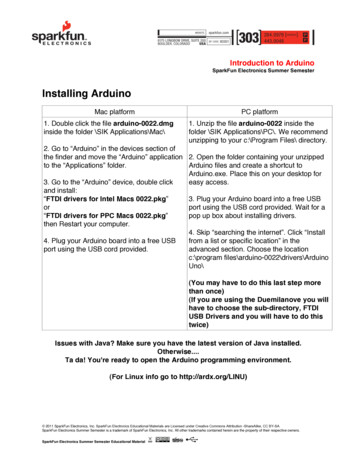




![History of Electronics electricity [Read-Only]](/img/18/history-20of-20electronics-20-20electricity.jpg)
